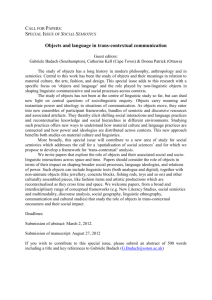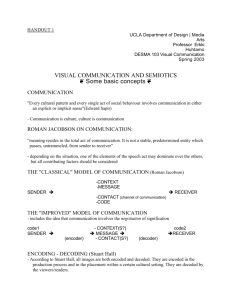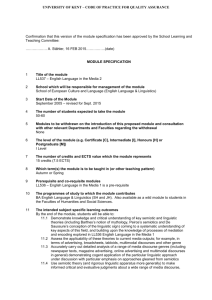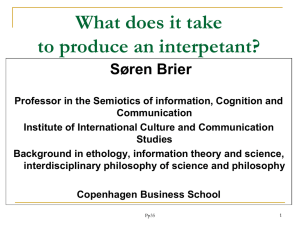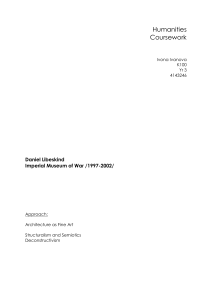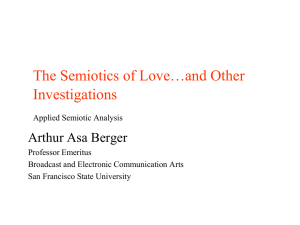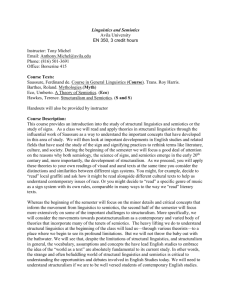Evolution of culture and the history of the media
advertisement
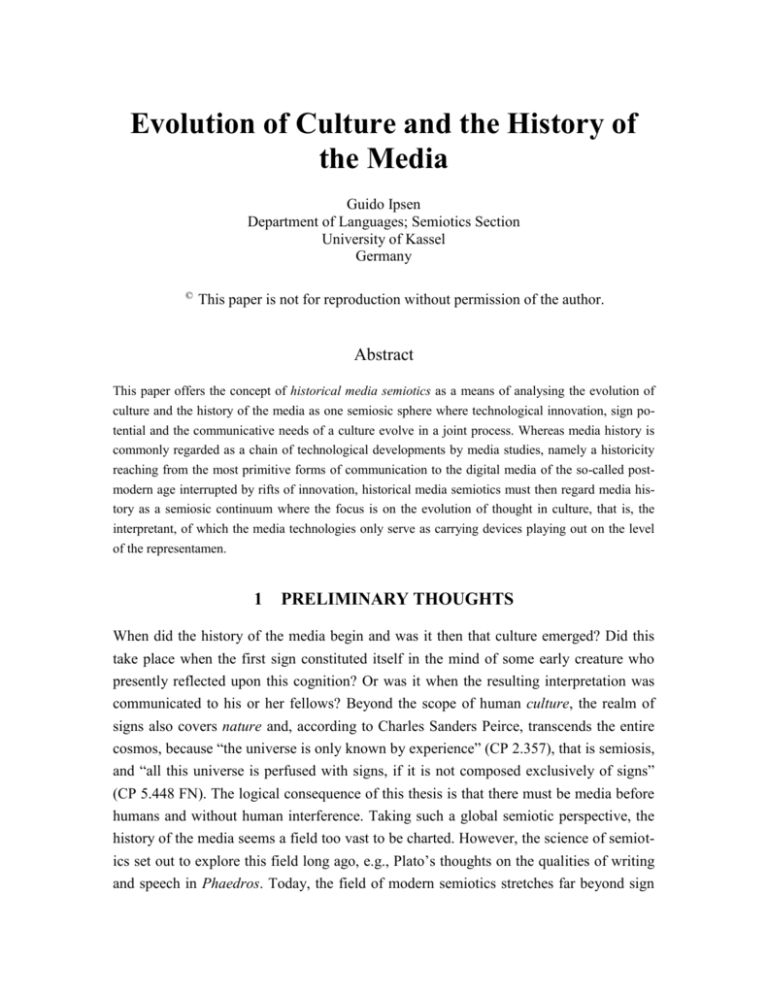
Evolution of Culture and the History of the Media Guido Ipsen Department of Languages; Semiotics Section University of Kassel Germany © This paper is not for reproduction without permission of the author. Abstract This paper offers the concept of historical media semiotics as a means of analysing the evolution of culture and the history of the media as one semiosic sphere where technological innovation, sign potential and the communicative needs of a culture evolve in a joint process. Whereas media history is commonly regarded as a chain of technological developments by media studies, namely a historicity reaching from the most primitive forms of communication to the digital media of the so-called postmodern age interrupted by rifts of innovation, historical media semiotics must then regard media history as a semiosic continuum where the focus is on the evolution of thought in culture, that is, the interpretant, of which the media technologies only serve as carrying devices playing out on the level of the representamen. 1 PRELIMINARY THOUGHTS When did the history of the media begin and was it then that culture emerged? Did this take place when the first sign constituted itself in the mind of some early creature who presently reflected upon this cognition? Or was it when the resulting interpretation was communicated to his or her fellows? Beyond the scope of human culture, the realm of signs also covers nature and, according to Charles Sanders Peirce, transcends the entire cosmos, because “the universe is only known by experience” (CP 2.357), that is semiosis, and “all this universe is perfused with signs, if it is not composed exclusively of signs” (CP 5.448 FN). The logical consequence of this thesis is that there must be media before humans and without human interference. Taking such a global semiotic perspective, the history of the media seems a field too vast to be charted. However, the science of semiotics set out to explore this field long ago, e.g., Plato’s thoughts on the qualities of writing and speech in Phaedros. Today, the field of modern semiotics stretches far beyond sign systems used in human communication (Nöth 2000). Semioticians explore the structures of genes and reflect upon computer communication. Umberto Eco’s semiotic threshold has been lowered significantly, widening semiotic investigation (cf. Nöth and Kull 2001). Nevertheless, though semiotics may be considered a “media science par excellence” (Nöth 1997: 5), the historical dimensions of the media have been scarcely examined, be they evolutionary or developmental. Or, rather, semioticians have not labelled their explorations of the history of culture a history of the media, though both are deeply intertwined, if not identical from a pragmatic perspective. Any branch of semiotics deals with manifestations of media, if we take the term as Peirce specified it. Therefore, as semioticians, we have at hand a toolkit for the examination of any communicative device used for the transport of signs. Moreover, as the science of signs, semiotics transcends the crude examination of technical means and we may therefore go beyond the shell of technologies in our investigation, redefining our approach and dedicating it to the thought itself. In a historical perspective, Peirce’s theory of semiosis also delivers a framework for investigating medial change. In the following, I will try to outline in what way a semiotically inspired history of the media, or, historical semiotics of the media, is able to fill gaps left by media studies in the narrower sense, or may interact in a transdisciplinary manner with media and culture sciences. 2 THE “MISSING LINK” IN THE HISTORY OF THE MEDIA The multitude and complexities of the media as conceived by media studies has led to a notable paradox: though media studies have focused on a deep examination of the media for decades, and separate media histories have been written, there is no single history of the media available, as Faulstich (2000: 29) remarks. Notwithstanding attempts at a broad history of communication, the mass of national differences, varying technological developments and research deficiencies are responsible for this. Nevertheless, the development of the media has been charted in several ways, always beginning with the earliest traceable communication devices used by the human race. Due to the fact that media studies have focused on the technological developments of medial carrier devices and the social impacts of their usage and application, the history of the media is conceived as being structured in certain epochs which mirror invention and change in the technological sphere. The labels for these epochs and the time frame vary. Faulstich (2000: 31-40) names four phases, only the first of which is dedicated to socalled primary or “human” media with little or no technological assistance, the latter having been used for writing or artistic purposes. According to Faulstich, this phase (40,000 BC – 1500 AD) was dominated by ritual and social forms of mediation. Secondary media are then print media (1500 – 1900), tertiary media are electronic media (1900 – 2000), and the latest phase is characterised by digital media, representing the present. Debray (1996: 26) defines the “chronological unifier” of media histories as the mediasphere, the “middle ground, setting or environment [milieu] of the transmission and carrying [transport] of messages and people.” These mediaspheres are much more specific and diverse than Faulstich’s phases. However, they too are based on the evolution of technological means which aid human communication: Historically, every mediasphere is specific to time and place, and our tables distinguish between three primary types: the logosphere, when writing functions as the central means of diffusion under the constraints and through the channels of orality; the graphosphere, when printed text imposes its rationality on the whole of the symbolic milieu; the videosphere, with its devitalization of the book via audiovisual media. This succession does not encompass, it will be noted, periods and societies without writing systems: it is properly speaking historical (post-Neolithic) (Debray 1996: 26-27). This chart of media history is at the same time narrower and wider than the first. Debray’s reason for excluding nonliteral societies or periods from investigation is logical, since his project of “mediology” (Debray 1996: 11) focuses on “higher social functions in their relations with the technical structures of transmission” (ibid.). Semiotically speaking, we do not need to judge which of these or other definitions of medial development is more fitful. In terms of sign systems, all exclusively focus on the sign carrier, the representamen in Peircean terminology. It is the focal point, the node around which everything else is arranged: the social impacts of the media, ideological issues, and so forth. Even in the beginnings of media analysis in the 20th century, Benjamin (1936) held the technology responsible for the corruption of art and society. The term media so far has been reduced to these material aspects. They are held to cause societal and cultural change. They are held to influence thought; not vice versa. Halbach and Faßler (1998: 33), e.g., argue that media are not merely “material shells”, but that they are levels of societal constitution in their own right. From the point of view of semiotics, all this is not necessarily wrong, but it is only part of the story. In signs, the representamen is but one of three aspects of thought, or the sign proper. It plays an important role in semiosis, but though it must not be neglected, it cannot be considered without the object or the interpretant. I will therefore argue that traditional media studies have looked at the media as given phenomena and not manifestations of thought, a strategy of which semiotic analysis may indeed prove to be capable. It seems to be the task of cultural semiotics to provide such a deep analysis of sign systems for cultural communication, superficially called “media”. However, cultural semiotics has itself been developing only for some twenty years. Its prime objectives are not to analyse the media at work in culture, but to discover the mechanisms of cultural evolution themselves (cf. Koch (ed.) 1989a, 1989b, 1989c, 1990; Eschbach & Koch (eds.) 1987). Since a semiotics of the media has meanwhile established itself (cf. Nöth (ed.) 1997; 1998), it seems that now two branches of semiotics are engaged in the same topic, sharing a field that should be tilled in joint venture. Winner (1987: 5-8) describes the scope of cultural semiotics in high detail, commencing with a clear statement: For us, the primary problems are those of meaning, how meaning and form are inextricably interrelated, how culture is understood as a complex form of communication through signs, and how such a view of culture can contribute towards a common perspective that unites all human behavior. Though Winner refers to precursors of cultural semiotics as well as the contemporary field of that science, she does not refer to the media as such even once. Instead, as can be found in most publications on that topic, the rather vague term “cultural sign systems” or the notion of “text” are mentioned, the first encompassing any system that serves for the communication of information in a given culture, the latter serving as the model for structuralist and poststructuralist theory. I do not wish to argue against the project of cultural semiotics. However, the missing link in media studies, namely a history of the media as a broad history of communication in culture, may be established by bringing media semiotics and cultural semiotics together, thus establishing a science of the history of thought, instead of a science of the carrier of thought, as mentioned above.1 In order to establish such a historical media semiotics, we must first establish the field and scope of such a project. 1 Peirce himself emphasized that semiotics is a science of thought (cf. Parmentier 1985: 44). I will show later how this fits perfectly in a semiotics of the media not oriented only along historical lines of technical developments. At this point, suffice it to say that the logical consequence of working on a science of thought is to establish a historical dimension to it. 3 CULTURE: THE COMMUNITY AND THE MEDIA In the words of Lotman (1981: 26-27), culture is the sum of information and its means for organizing it. Though Lotman does not expressly name the means for organisation of information media, and despite his exclusive view on the synchronic structure of a given culture, we may extend this statement and give this information community the background of historicity. Such an information based community can only develop and grow by making use of media to transmit inherited information to a next generation. This is how semiosis works on a broad cultural scale. It is neither imaginable that cultural growth is possible without the development of the media, nor can technological progress happen without the preconditions of cultural development. As Jameson (1991: 68) suggests, the recognition of medial influence on culture has but recently proven that media have always played an important role in human history: It is because we have had to learn that culture today is a matter of media that we have finally begun to get it through our heads that culture was always that, and that the older forms and genres, or indeed the older spiritual exercises and meditations, thoughts and expressions, were also in their very different ways media products. The intervention of the machine, the mechanization of culture, and the mediation of culture by the Consciousness Industry are now everywhere the case, and perhaps it might be interesting to explore the possibility that they were always the case throughout human history, and within even the radical difference of older, precapitalist modes of production (ibid.) This brings us to the two main aspects of investigation of a historical semiotics of the media. First, “media” must not be understood as technical means for information transport only. Second, the timeframe for “history” in respect of media history is not absolute, but depends on our definition of “media”. The more basic our notion of media, the further back in history we may look. Therefore, a semiotic history of the media should be a soft science. I will try to establish a short definition of “media” on the basis of Peircean semiotics which will enable us to focus on the history of thought rather than technology. I will not deny the fact of technology in the media, which would be ridiculous. It is the working principle of communication science (cf. Nöth 2000: 467). However, this paper argues that a truly semiotic theory of the media equals Peirce’s theory of the sign. Therefore, I will try to mediate between media studies and semiotics, acknowledging semiotics as the master discipline, since technical media are indeed the means for sign usage, which in itself is the subject matter of semiotics (cf. Nöth 1998: 48). Peirce himself stated the terminological identity of the terms sign and media when he wrote: "All my notions are too narrow. Instead of ‘Signs’, ought I not to say Medium?" (MS 339; cf. Parmentier 1994: 23). Indeed Peirce often uses media equivalent to the Third (cf., e.g., CP 1.322, 1.342, 1.382). Signs serve to mediate, so the Third is the “medium of connection” (CP 1.297). The general definition of the Third includes the notion of the media: “By the third, I mean the medium or connecting bond between the absolute first and last. The beginning is first, the end second, the middle third. The end is second, the means third” (CP 1.337). In the Peircean triad, the medium takes the place of the rule, or relation. To “mediate” here is used in the pure meaning of the word, because a First and a Second lack in themselves the aspect of relation between each other; this can only be established by a third. In short, mediation happens between them and hence the sign may be established: The first is that whose being is simply in itself, not referring to anything nor lying behind anything. The second is that which is what it is by force of something to which it is second. The third is that which is what it is owing to things between which it mediates and which it brings into relation to each other (CP 1. 356). Hence, mediation is equal to “intellectual triplicity” (CP 2.86), or, according to Peirce (ibid), the “machinery” enabling us to make assumptions about the future on the basis of long-term experience. According to Peirce, the medium as mediating force proper is seen in relation to the intellect. Mediate and immediate experience, or cognition, are not different in that things in themselves have or lack the quality of mediating. Mediation in itself is the third instance established by the interpreter (CP 5.223). Thus, a valid assertion about immediate experience is not possible in the first place (CP 5.224): To set things in relation to each other, semiosis, the production of signs, is always part of cognition as mediation: No present actual thought (which is a mere feeling) has any meaning, any intellectual value; for this lies not in what is actually thought, but in what this thought may be connected with in representation by subsequent thoughts; so that the meaning of a thought is altogether something virtual. It may be objected, that if no thought has any meaning, all thought is without meaning. But this is a fallacy similar to saying, that, if in no one of the successive spaces which a body fills there is room for motion, there is no room for motion throughout the whole. At no one instant in my state of mind is there cognition or representation, but in the relation of my states of mind at different instants there is. In short, the Immediate (and therefore in itself unsusceptible of mediation – the Unanalyzable, the Inexplicable, the Unintellectual) runs in a continuous stream through our lives; it is the sum total of consciousness, whose mediation, which is the continuity of it, is brought about by a real effective force behind consciousness (CP 5.289). Still, Peirce also uses the expression “to mediate” for the function of the representamen: “A Representamen mediates between its Interpretant and its Object, and that which cannot be the object of the Representamen cannot be the Object of the Interpretant” (CP 2.311). Does this make the representamen the medium alone? Peirce himself gives the answer and we do not have to make a difference between the representamen as a medium in the broad sense and thirdness in the narrow sense. Despite the fact that Peirce uses the terms sign, object, and medium ambiguously, devising his categories differently at times, the following passage allows us to see the difference in high detail: A sign mediates between the interpretant sign and its object. Taking sign in its broadest sense, its interpretant is not necessarily a sign. Any concept is a sign, of course. [...] But we may take a sign in so broad a sense that the interpretant of it is not a thought, but an action or experience, or we may even so enlarge the meaning of sign that its interpretant is a mere quality of feeling. A Third is something which brings a First into relation to a Second. A sign is a sort of Third. How shall we characterize it? Shall we say that a Sign brings a Second, its Object, into cognitive relation to a Third? That a Sign brings a Second into the same relation to a first in which it stands itself to that First? If we insist on consciousness, we must say what we mean by consciousness of an object. Shall we say we mean Feeling? Shall we say we mean association, or Habit? These are, on the face of them, psychological distinctions, which I am particular to avoid. What is the essential difference between a sign that is communicated to a mind, and one that is not so communicated? If the question were simply what we do mean by a sign, it might soon be resolved. But that is not the point. We are in the situation of a zoölogist who wants to know what ought to be the meaning of “fish” in order to make fishes one of the great classes of vertebrates. It appears to me that the essential function of a sign is to render inefficient relations efficient, - not to set them into action, but to establish a habit or general rule whereby they will act on occasion (CP 8.332). The representamen, here named the sign, does mediate between the object and the interpretant, but it is the result, the habit or rule established, which makes the whole process fruitful. Only by rule or habit, the connection between object and interpretant becomes obvious for the interpreter in the future. The rule, however, is thirdness per se, which brings us back to the beginning of this train of thought. To equate signs with media thus means to view the results of individual semiosis (CP 2.303, 2.92). It means to focus on the rules and habits which allow us to integrate the surrounding world to the sum of experience. That the representamen is part of the sign, is a logic consequence and trivial. But it is the categories of the signs which are responsible for cognition instead the other way round; in other words: the physical nature of the representamen is secondary, while the mental rules of cognition are primary, because the representamen, called the sign in the following quote, is not identical with the thought: Not that the particular signs employed are the thought! Oh no; no whit more than the skins of the onion are the onion. (About as much so, however.) One selfsame thought may be carried upon the vehicle of English, German, Greek, or Gaelic; in diagrams, or in equations, or in Graphs: all these are but so many skins of the onion, its inessential accidents. Yet that thought should have some possible expression and some possible interpreter, is the very kind of its being (CP 4.6). This liberty of representation can be paraphrased with the disappearance of the signifier (cf. Parmentier 1985: 44). For Peirce, signs are media of communication. The representamen as such, however, in its ideal form, would be of, so to speak, transparent nature. In other words, the “garment of expression” (NEM 3.406, 1903, cf. Parmentier 1985: 44) which is required to communicate thought, requires the representamen to play its role. This is true in self-reflection as well as in conversation with others. However, in an ideal case, namely the absolute transparence of the sign as concerning the processes of determination and representation, the signifier is doomed to vanish. For a science of thought, the physical shell of thoughts is unimportant. Peirce himself reminds us of the communicative force of the sign as medium. The form of the representamen is only secondary: After an ordinary conversation, a wonderfully perfect kind of sign-functioning, one knows what kind of information or suggestion has been conveyed, but will be utterly unable to say in what words it was conveyed, and often will think it was conveyed in words, when in fact it was only conveyed in tones or facial expressions (MS 283.128-130, 1905, cf. Parmentier 1985: 45). With this in mind, the term medium, or media, cannot mean technical devices only in semiotic contexts. If any sign is a medium, media studies begin at the very point of thinking and extend in the realm of communication of thoughts. To bring this semiotic basis in accordance with traditional media studies, it seems worthwhile to investigate in which ways the modes of communication have influence on the thought, and vice versa. 4 THE PRAGMATIST APPROACH TO HISTORICAL MEDIA SEMIOTICS To focus on the sign as a mental instance reduces the technical devices commonly called media to the means of uttering, recording, or transporting information to a certain end. These ends of mediation in culture are rooted in the context of society. As you can see, a pragmatist view of media history must focus on society first and then see the media as indicators for a way of thinking. Thus, mass reproduction will not corrupt aesthetics, as Benjamin feared. Mass production is the sign for the yet diminished value of aesthetics – if one is to accept that mass production and aesthetics will not get along well in the first place, which I doubt. There surely is no simple answer to this question. Any change that occurs in sign systems, however, hints at some deep change that is in effect in culture. Changes that are detectable must then occur in the form of new signs, hence be the result of semiosis. We can therefore paraphrase semiosis with mediation. 5 THE POTENTIAL OF SIGN SYSTEMS AND CULTURAL DEVELOPMENT If the rule, or the habit, or the general fact is the outcome of semiosis, then this is surely situated in the future, as Peirce confirms: Whatever is truly general refers to the indefinite future; for the past contains only a certain collection of such cases that have occurred. The past is actual fact. But a general (fact) cannot be fully realized. It is a potentiality; and its mode of being is esse in futuro. The future is potential, not actual. What particularly distinguishes a general belief, or opinion, such as is an inferential conclusion, from other habits, is that it is active in the imagination (CP 2.148). The projection of the rule into the future is also valid for the role of the media in cultural terms: the ultimate potential of the sign systems which we call the media, such as television, the telephone, writing systems, and so forth, can never be estimated at the moment of its introduction. The habits of usage will change over time. I deem the telephone to be the most prominent example of these developments. Alexander Graham Bell never imagined that his invention might some day be converted to a portable device used for entertaining purposes by a mass audience. And we do not yet know the potential of telecommunication technology. Now we may redefine the evolution of culture as a developmental movement along the lines of the potentials that this given culture is offered by the sign systems it uses. Naturally, since semiosis is not supposed to come to a standstill, innovation will take place if the community of sign users will develop communicational needs that go beyond the scope of the media it uses. Hence, e.g., the development of media supporting longdistance communication. Since the sign is essentially mental in nature, the aggregate of the thought is responsible for the development of new technologies which will in turn offer new potentials for the culture to use. The development of thought and the consciousness of the community of its own communicative needs is dependent on a consensus on the present state of thought: Finally, as what anything really is, is what it may finally come to be known to be in the ideal state of complete information, so that reality depends on the ultimate decision of the community; so thought is what it is, only by virtue of its addressing a future thought which is in its value as thought identical with it, though more developed. In this way, the existence of thought now depends on what is to be hereafter; so that it has only a potential existence, dependent on the future thought of the community (CP 5.316). These processes of technological innovation and creative use of potentials will take place repetitively in the evolution of the culture, and they are intertwined, just as the three apices of Peirce’s sign model make up the whole. They cannot be separated. Technology is surely not the master of cultural evolution, it rather offers semiosic potential in the development of thought. Supposedly, the cultural development, and hence semiosis, will therefore come to a standstill if the potentials of any sign system will be “used up”, thus establishing a continuum of perfect order. Until this moment, the processes of innovation and evolution will never come to an end, as figure 1 illustrates. potential sign potential cultural evolution along the potentials of sign systems technolocical innovation time Figure 1: Evolution of a cultural continuum along the lines of sign potentials. Whenever the potential of the sign systems merges with the actual cultural usage of that system, innovation is a point of necessity. New potentials are set free, which will eventually merge with cultural practice as the precursors. However, the usage of a sign system close to the innovation node may only be a harbinger of what is possible in the future. 6 MEDIA HISTORY AND SEMIOSIS Representation and determination are the opposed concepts at work in semiosis. While determination works in a way that an object determines its representamen, or the first sign, and the representamen determines the resulting interpretant as the second, or new sign in semiosis, representation is understood the other way round: representation in the triadic model of Peirce is defined as the “act or relation in which one thing stands for something else to the degree that it is taken to be, for certain purposes, that second thing by some subject or interpreting mind” (Parmentier 1985: 209). Let us consider examples by Peirce to fully understand these processes. First, determination is believed to be a concept that, according to Peirce, increases the “depth” or intension of a term (CP 2.428). Hence the example of color: color in itself is a determination of some quality of an object, red is the determination of the quality of color, and scarlet is the determination of the quality of redness. Moreover, the sign, as the represen- tamen in this case, plays only the role of the mediator between object and interpreting mind: A Sign is a Cognizable that, on the one hand, is so determined (i.e., specialized, bestimmt,) by something other than itself, called its Object, while, on the other hand, it so determines some actual or potential Mind, the determination whereof I term the Interpretant created by the Sign, that that Interpreting Mind is therein determined mediately by the Object (CP 8.177). Examples for representation work the other way round: In Peirce’s sense of representation “a word represents a thing to the conception in the mind of the hearer, a portrait represents the person for whom it is intended to the conception of recognition, a weathercock represents the direction of the wind to the conception of him who understands it, a barrister represents his client to the judge and jury whom he influences“ (CP 1.553). I think we can have a short excursion here on the topic of truth, or in other words, reality. Indeed, there is the question as to whether the object has the power of determining, via the representamen, the interpretant in a way that leads us to say that there is some inherent truth in the resulting sign, or interpretant. Peirce gives us two answers to this question, from which the pragmatic character of semiosis becomes quite obvious. First, the sign has the power of resisting the interpretant’s power of representation, as Parmentier puts it, according to Peirce: If a thing has whatever characters it has regardlessly of what any men existing either now or at any assignable future date may opine that its characters are, that thing is, by definition, perfectly real. But in so far as it is what the thinker may think it to be, it is unreal. Now I say that the object of a sign must resist in some measure any tendency it may have to be as the thinker thinks it (MS 499, cf. Parmentier 1985: 28). From this, we can see that there must be a relation within the triadic system of the sign which leads the interpretant to represent the object in the same way the representamen does. In other words, a way of interpreting a sign that cannot be granted by the representamen as first mode of representation cannot be regarded as revealing truth. Second, the aspect of the remaining fallacy of any interpretant projects the revelation of some possible truth about the objects of the real world into the future. Semiosis itself is based on the process of experiencing, of having new experiences added to those already processed in the mind of the thinker, or interpreter. Any new experience may change the knowledge or beliefs about the world as such, or specific objects in that world. The hori- zon of experience is therefore subject to eternal change, and the basis on which social interaction works can only be of relative permanence. There must hence be some consensus on a social scale about the truth of the interpretant, as we will see later. In the processes of determination and representation, an inherent asymmetry can be found. Determination of the representamen by the object and consequently of the interpretant by the representamen play out on the same level. However, representation does not work its way back the same way, as we have seen before. There is a metasemiotic conception of the relation between representamen and object which enables the interpretant to represent the latter. In order to function as such, the interpretant must be, and is, capable of representing not only the object itself, but also the determining relation that exists between an object and its representamen, which Peirce calls the ground. The ground is some respect, character, reason, or quality that brings the sign into connection with its object (CP 5.283, cf. Parmentier 1985: 30). By representing the ground, the interpretant thus creates a new entity, or new interpretant. Coined on the example of colors, this process would mean to change the focus from the quality of “red” of an object to the quality of redness as such, which plays out between the representamen and the object. One further quote exemplifies what we are about to discuss when we apply this conception of the signifier to the problem of the media: A sign [...] just in so far as it fulfills the function of a sign, and none other, perfectly conforms to the definition of a medium of communication. It is determined by the object, but in no other respect than goes to enable it to act upon the interpreting quasi-mind; and the more it fulfills its function as a sign, the less effect it has upon the quasi-mind other than that of determining it as if the object itself had acted upon it. Thus, after an ordinary conversation, a wonderfully perfect kind of sign-functioning, one knows what information or suggestion has been conveyed, but will be utterly unable to say in what words it was conveyed, and often will think it was conveyed in words, when in fact it was conveyed in tones or facial expressions (MS 283.128-130, 1905, cf. Parmentier 1985: 45; my emphasis). Hence, the signs of communication convey meaning, but in a Peircean sense they are utterly unable to influence that meaning. As Parmentier puts it, signs are “blind vehicles” (1985: 45). Therefore, signs are indicators for cultural change in the first place. 7 CONSENSUS AND CHANGE IN THE HISTORY OF THE MEDIA The interaction between the media and their users on a social scale has been analysed by various scholars. Müller (1996: 284) regards the embedding of media use in the social milieu as commonplace in media studies. He differs between two approaches. First, theory-based historical media studies will, according to Müller, try to reconstruct abstract schemata of social action. Second, a historical media pragmatics examines “specific medial schemata of action in specific historical contexts” (Müller 1996: 284-285; my translation). Historical media pragmatics are based on historical text pragmatics, as conceived by Gumbrecht (1978). The aim is to take the situations of text production and reception into account when considering the historical dimension of texts, or media in general. Müller specifies what “specific contexts” are. He calls these the “situative horizon”: As elements of the situative horizon, we may name: the basic conditions of human action in space and time, specific given facts and processes of social history and mentality, the socio-historical amount of knowledge (which has to be divided into different levels, including all levels of the ‘knowable’, i.e. as well the preconscious and unconscious), language, which plays a central role in the construction of social reality, and créances (i.e., usually unquestioned elements of knowledge that guide our behavior and actions and taken for the truth) (Müller 1996: 286, my translation). In the terms of Peircean semiotics, all these elements of the situative horizon are the interpretant in the quasi-mind of the interpreter. On the basis of experience, we are indeed able to interact as well on a social scale as we are able to interact with the world in general. Actually, both spheres are one and the same. In the situative horizon we may therefore find the consensus mentioned earlier, where the community of interpreters shares the same sum of experience. There is some at least temporally available consensus derived from experience. This is what Mead defines in extensive detail when speaking about the mind in its social context: We must regard mind, then, as rising and developing within the social process, within the empirical matrix of social interactions. We must, that is, get an inner individual experience from the standpoint of social acts which include the experiences of separate individuals in a social context wherein those individuals interact (Mead 1934: 133). Mead continues by making clear that experience has a value as such only in social interaction as the constituting element of a social mind. From this, the development of a social continuum is explained by the contribution of the individual’s experience to those of the group. In a Peircean context, the working basis of society as institution, its Weltanschauung and so on is therefore subject to change as conceived by the process of semiosis. This notion is also of major importance for the history of the media as mirror of cultural change. What comes into play here is the relation of the mediated to its mediators, namely the community of interpreters. Stanley Fish coined the term of the interpretive community in the tradition of pragmatism when discussing the truth of interpretations of texts: What was required was an explanation that could account for both agreement and disagreement, and that explanation was found in the idea of an interpretive community, not so much a group of individuals who shared a point of view, but a point of view or way of organizing experience that shared individuals in the sense that its assumed distinctions, categories of understanding, and stipulations of relevance and irrelevance were the content of the community members who were therefore no longer individuals, but, insofar as they were embedded in the community’s enterprise, community property. It followed that such community-constituted interpreters would, in their turn, constitute, more or less in agreement, the same text, although the sameness would not be attributable to the selfidentity of the text, but to the communal nature of the interpretive act (Fish 1989: 141). The interpretive community is not only established in reading texts. It is identical with the cultural communities using media. The horizon of experience, once again, binds the individuals together. The notion that the interpretive force does not lie within the text, but in the community of readers, may thus be extended to the statement that the cultural community brings forth medial change instead of the media taking influence on culture. 8 METHODOLOGY The necessary research must cover three areas. First, the intellectual context of medial change is of utmost importance. Second, the actual use of the media over time is of interest. Third, the potential of the media that has been used so far must be mapped. As for the first area, we need to find out about the contemporary reactions that were recorded at the advent of new technologies. These reactions may express hopes, fears, criticism or consensus. At any rate, they map the zeitgeist and hence allow us to ascertain the cultural context in accordance with the regular heap of empirical data about the use of various technical media at a given time. From these data, we can discover a diachronic analysis on the use of media alongside the intellectual history of culture. The impact of certain technologies on the way of thinking, on cultural evolution, can be measured this way. Hence, the second area will deliver results on how long it took for the so-called medial revolutions to take place, or whether these are a post-analytic myth in the first place. The potential of a medium may grow, or it may prove rather small from the beginning. For example, the potential of pictographic writing is reasonably small, while the medial potential of the computer cannot be measured to the present day. The inherent power of sign systems to evolve is restrained by this medial potential. In the case the limits of the potential are reached, the sign system has to be abandoned and replaced by a more powerful one, or it has to undergo thorough changes. Both mark the upper limit of the system’s potential in its first form. Adaptive systems, such as those based on digital machinery, may even change in a way that is not easily recognised. Computer systems have changed on a macro level, that is, the range of executable functions, but they have also changed on a micro level, namely the programming languages that maintain those macro functions. Each medium has its own range of potentials which needs to be analysed in the light of the respective intellectual and cultural context. This approach requires transdisciplinary efforts. Social and political studies must be taken into consideration when examining the cultural community of a given era. Media studies have supplied a large variety of media histories for separate media. Thus, historical media semiotics is not an entirely new approach, but is embedded in the traditions of other disciplines, providing a fresh point of view based on Peircean theory of the sign. Applying Peircean semiotics to historical media and culture studies does not mean to enlarge the linguistic field universally, or have investigation become exclusively linguistic in orientation, as Jameson (1991: 68) suggests, since Peirce’s model of semiosis does not apply to human language only; it is a universal model of cognition and communication. REFERENCES Benjamin, Walter. [1936] 1963. Das Kunstwerk im Zeitalter seiner technischen Reproduzierbarkeit. Frankfurt/Main: Suhrkamp. Debray, Régis. 1996. Media Manifestos. London: Verso. Eschbach, Achim and Walter A Koch (eds.). 1987. A Plea for Cultural Semiotics. Bochum: Brockmeyer. Halbach, Wulf and Manfred Fassler. 1998. Einleitung in eine Mediengeschichte, in: Fassler and Halbach (eds.) 1998. Geschichte der Medien, pp. 17-53. München: Fink (=UTB 1984). Faulstich, Werner. 2000. Mediengeschichte, in: Faulstich 2000. Grundwissen Medien, pp. 29-41. München: Fink. Fish, Stanley. 1989. Doing What Comes Naturally. Oxford: Clarendon Press. Gumbrecht, Hans Ulrich. 1978. Receptie esthetika en handlungstheoretische literatuurwetenschap, in: Grivel, Charles (ed.), Methoden in de literatuurwetenschap, pp. 167183. Muiderberg. Jameson, Fredric. 1991. Postmodernism, or, the Cultural Logic of Late Capitalism. Durham: Duke University Press. Koch, Walter A. (ed.). 1989a. Culture and Semiotics. Bochum: Brockmeyer. —. 1989b. Evolution of Culture. Bochum: Brockmeyer. —. 1989c. The Nature of Culture. Bochum: Brockmeyer. —. 1990. Aspekte einer Kultursemiotik. Bochum: Brockmeyer. Lotman, Juri M.. 1981. Kunst als Sprache: Untersuchungen zum Zeichencharakter von Literatur und Kunst. Leipzig: Reclam. Mead, George Herbert. 1934 [1967]. Mind, Self, and Society. Ed. Morris, C.W. Chicago: University Press. Müller, Jürgen E.. 1996. Intermedialität: Formen moderner kultureller Kommunikation. Münster: Nodus Publikationen. Nöth, Winfried. 1997. Introduction, in: Nöth, Winfried (ed.). Semiotics of the Media, pp. 1-11. Berlin: Mouton de Gruyter. —. 1998. Die Semiotik als Medienwissenschaft, in: Nöth, Winfried and Karin Wenz (eds.). Medientheorie und die digitalen Medien (=Intervalle 2 – Schriften zur Kulturforschung), 47-60. Kassel: University Press. —. 2000. Handbuch der Semiotik. 2., vollständig neu bearbeitete Auflage. Stuttgart: Metzler. Nöth, Winfried and Kalevi Kull (eds.). 2001. The Semiotics of Nature. Tartu: University Press [Special Issue: Sign System Studies 29.1] & Kassel: University Press (online edition). Peirce, Charles Sanders. 1931-58. Collected papers, Vols 1-6, ed. Hartshorne, C. and P. Weiss, vols. 7-8, ed. Burks, A.W. Cambridge, MA: Harvard University Press. Citations in text are by volume and paragraph number. Winner, Irene Portis. 1987. Semiotics of culture vs. other cultural sciences, in: Eschbach – Koch (eds.) 1987: 4-22.

